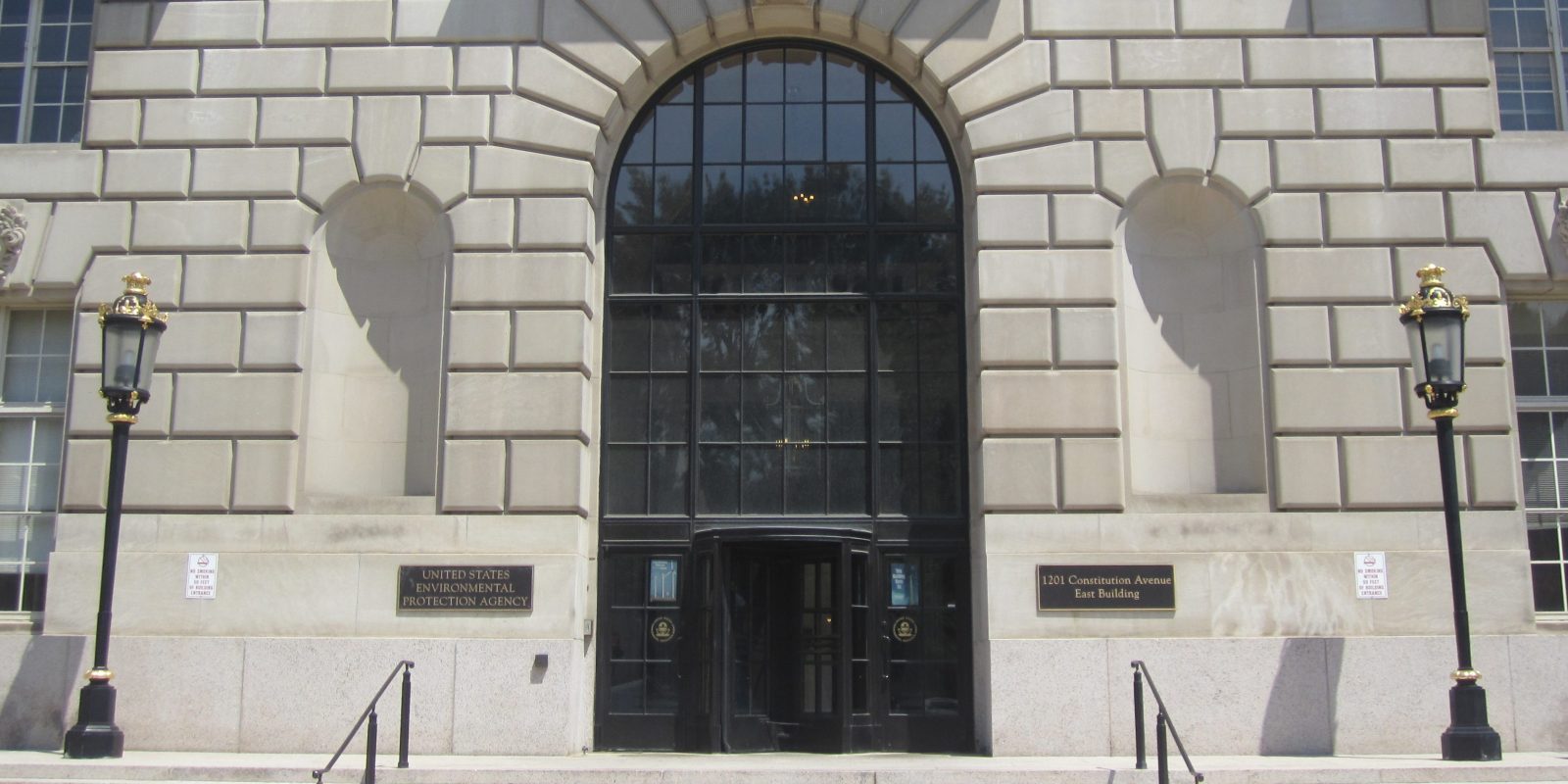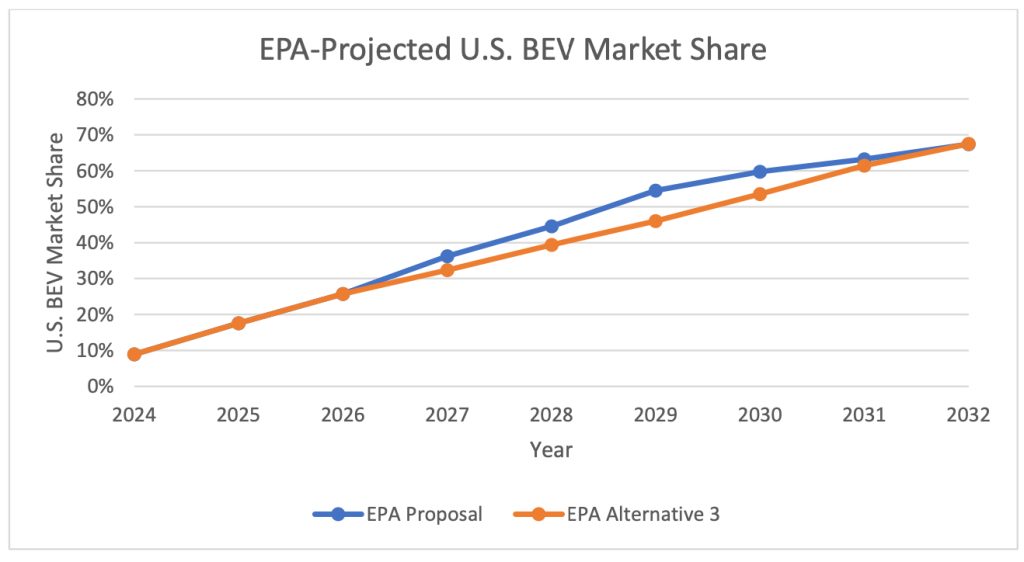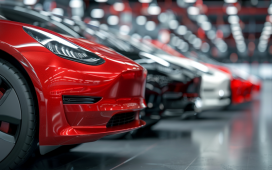
The EPA has finalized its proposed 2027-2032 emissions rule, which is expected to result in a large increase in zero emission vehicle sales as vehicle exhaust limits rise rapidly through the end of the decade, on top of a separate rule yesterday from DoE about EV mpg-equivalents. Both rules were softened from their original proposals just like automakers asked for, but the largest automaker lobbyist is still complaining.
The regulations have just come out, so we’re still looking through them, but in the last few days there had been reports that the curve has been somewhat softened to allow more time for compliance, while maintaining roughly the same targets for 2032.
This softening is in accordance with requests from both the Alliance for Automotive Innovation (AAI), the main auto industry lobby group which has routinely lobbied to torpedo emissions standards in the past, and the United Auto Workers union (UAW), who worried that domestic auto production, which focuses disproportionately on high-polluting trucks and SUVs, would be disproportionately affected by the new rule.
It also comes hot on the heels of a false media narrative that EV sales are slowing, which they are not. But this narrative has been seeded in the media over the course of the past few months, likely in an attempt to influence these very regulations. It seems that industry lied hard enough, successfully enough, and media blindly took the bait often enough, to successfully create a false narrative that influenced a softening of the regulations.
The originally-proposed rule set emissions targets that would likely result in a 60% EV new car market share in 2030, rising to 67% in 2032. But the rule did not and does not mandate an EV share – it merely sets emissions targets which would likely necessitate that level of zero emission vehicle penetration to meet.
The rule is “technology neutral” in that those emissions limits can be met with a higher mix of more-efficient hybrid vehicles, or with fuel cell vehicles, or with battery electrics, or with whatever else. It is expected that the vast majority of zero emission vehicle production to help meet the rule will be battery electric, though.
But the proposal included multiple “alternatives” accounting for different adoption scenarios, with some accelerating more quickly in earlier years, and some curving upwards later on. AAI and UAW favored delayed adoption curves, while Volvo, Tesla, Rivian and Lucid all supported stronger alternatives. You can see what each automaker supported here.

And of course, doctors, nurses, scientists, environmental groups, people who recognize that they have lungs which they would like to continue using, and so on, generally support the strongest regulation possible. But who listens to those idiots anyway?
It seems that EPA has landed roughly on alternative 3, which is the alternative that was requested by AAI, the industry lobby group who has previously utilized lies in the process of lobbying for more death and higher fuel costs for Americans, rather than the alternative requested by public interest organizations who have not tried to kill you.
This alternative means significantly less savings, significantly more pollution and significantly more death than the proposed rule in the short term, but it does still represent enormous progress over the status quo, and even a big improvement from President Biden’s 2021 executive order targeting 50% EV sales by 2030. And the administration says that it still cuts the same amount of emissions in the long term, over 30 years.
This improvement was possible due to the rapid growth in EV sales, availability of EV technology, and widening of available EV models, all of which gave EPA the confidence to offer a reasonably strong tailpipe rule.
And the finalized rule will still save Americans $100 billion dollars in fuel costs and health and climate benefits per year, and save some 2,000 lives per year, along with many other benefits. Though the savings per vehicle is down from $12,000, which was the number quoted in the original rule, to $6,000, which is the number quoted by the administration’s press release today.
And quite importantly, there is one line in the finalized rule which suggests the EPA understands it has made mistakes in the past by separating emissions regulations for cars and “light trucks” (SUVs). This favorable treatment for light trucks has been credited with helping to cause ballooning vehicle sizes, which has swallowed up any progress we could have made on auto emissions.
By proposing to “narrow the numerical stringency difference between the car and truck curves,” EPA intends to reduce favorable treatment for light trucks, which means we might actually be able to buy a normal f%&(ing sized vehicle in America again in a decade or two (save us R3, you’re our only hope).
And so, despite the weakening of the rule, it was still praised by the Alliance of Nurses for Healthy Environments, Consumer Reports, and the League of Conservation Voters, among many other organizations due to the significant health, consumer and environmental benefits it will bring.
Sierra Club and Public Citizen also recognize the improvement the regulations represent, but point out how intense lobbying from automakers and auto dealers worked to water down the rules at the expense of our climate.
DoE Petroleum Equivalency rule also released
In addition to today’s EPA rule, the Department of Energy released a separate rule yesterday, concerning a “Petroleum Equivalency Factor” which decides how EVs are treated in fuel economy calculations. Currently, EVs get a tremendous benefit, meaning that automakers have to make a comparatively low number of EVs to bring their fleet average up to required levels.
The new PEF rules reduce the benefit that EVs get in this calculation. This is not because EVs aren’t clean, but rather so that automakers can’t build a bunch of polluting vehicles and a few clean vehicles just to pump their averages up. The new PEF will ensure that automakers need to make suitable amounts of EVs, instead of just a few compliance cars that give them a lot of bonus points.
This is in contrast to what AAI said about the new PEF rule, suggesting that it is a bad change which will disincentivize EV production because it reduces the benefit EVs get. This is not correct, relies on a misunderstanding of how averages work, and seems simply to be an attempt to get the mathematically-ignorant to go along with AAI’s anti-environment stance. Either that or John “does your head hurt?” Bozzella really can’t figure out how to do Junior High-level mathematics.
But the PEF rule, too, was loosened before implementation, reducing EV fuel economy calculations by 65%, rather than the 72% requested by the Natural Resources Defense Council (NRDC) and Sierra Club. This means that EVs will still get probably a little more credit than they deserve, allowing automakers to still make a few more polluting vehicles than they would have with a stricter cut (though EVs will still have enough benefit to encourage their use over, say, gas hybrid vehicles).
Sierra Club and NRDC still praised the new PEF rule even after its weakening. Pete Huffman, senior attorney at NRDC, said “The automakers’ free ride is over. This important update from the Department of Energy will curtail automakers’ use of phantom credits they used to keep selling gas guzzlers. They now need to hit the accelerator on more fuel-efficient vehicles, saving consumers money at the pump.”
There is one more rule still coming, an update to the Corporate Average Fuel Economy (CAFE) rule, which will incorporate the PEF rule into its mileage calculations. We’re not sure quite when that will come out, but it will likely show up by the end of the month, which will help protect it from potential legal challenges should the US elections in November result in a leading party that is hostile to human existence, and wants to continue to force pollution down our throats rather than give Americans the choice to drive cleaner vehicles.
Electrek’s Take
I and many other people who have lungs are disappointed by the softening of these regulations today.
These are still very good regulations. After reading the initial proposed rule, I was impressed and refreshed by how exceedingly well-reasoned they were. Especially compared to the previous four years of lying incompetence under former EPA leadership (which is back on the table as a possible option come November, so you might want to get your ballots ready to oppose that). It’s nice to read government speak plainly about the necessity of a regulation, how it will help, how it will be achieved, and that it is achievable, all supported with real science.
And, in particular, I’m over the moon about the inclusion of the part about “narrow[ing] the numerical stringency difference between the car and truck curves.”
But why is it that every single time we have to hear the same story:
- Public interest groups beg for an eminently achievable improvement that will help everyone.
- Industry screams about how impossible that improvement would be (it isn’t) and spends a ridiculous amount of money that only they have in order to influence it.
- Government (at least serious government, which is to say, not the lying incompetents at the helm of the EPA from 2017-2021) examines the two cases and compromises to come up with a rule that is achievable, but isn’t as much in the public interest as it could be since it has been watered down by expensive lobbying efforts by polluting industry.
- Public interest groups still say that it would be nice for everyone if the rule was made a little better.
- Industry says there’s absolutely no way they can possibly do the compromise, and you need to make it “better” (aka, worse for living beings).
- Government compromises again, always away from the direction of public interest groups, and gives industry exactly what they wanted.
- Industry whines anyway and sues to stop the rule entirely, despite already getting two compromises in their favor, because those compromises still don’t kill nearly as many people or cost the public as much money and misery as industry desperately needs. And then begs for a reversal of the rule entirely come the next change in government (again, get your ballots ready for November).
We all recognize this pattern, right? This is not the first time it has happened, and it won’t be the last. But I contend that we have to stop negotiating with these environmental terrorists. They’re the ones who led us here, so I see no reason that they should have a greater seat at the table than those of us who have to breathe in the garbage that they keep pumping into the air without consequence. The EPA has made a fundamentally good rule, but watering-down its implementation was not the right choice.
But in the end, maybe it doesn’t matter. The current rise in EV sales has come well in excess of the underlying environmental regulations. This rule sets a floor, not a ceiling, and the market can exceed these targets as more and more consumers recognize the superiority of electric vehicles, and that it’s probably a pretty poor idea to buy a gas car when the technology doesn’t have much of a future going for it.
We’ve seen it happen elsewhere, with Norway well above 90% plug-in car sales in advance of its 2025 target, and with China’s EV penetration rising incredibly rapidly, which caught foreign automakers by surprise.
These regulations are important and ensure that everyone gets on the same page – and, frankly, laggard automakers should probably thank the government for encouraging them to get on board. If emissions progress continues to exceed regulatory minimums, as it so far has, laggard companies are going to be left out even more if they just aim for the absolute minimum. And in that respect, weakening of the standards is bad for these laggard companies who lobbied for it, not good.
By raising that minimum, government is giving the likes of Toyota or Stellantis the kick in the pants they might need to get their act in gear. Because the industry is going to be upended, and laggards will be left behind.
Or maybe they’ll just sit on their hands and sue. Again. Oh well. We tried to save you and you just didn’t listen.
Featured Photo by Billy Hathorn
Automakers celebrate getting to kill more people as EPA softens final exhaust rule
EPA kicks the can down the road to 2030 with a weakened final exhaust rule
EPA softens rule that will save you trillions and automakers are still mad about it
EPA finalizes rule to save you trillions and automakers are still mad about it
As EV sales soar, EPA throws cold water by loosening proposed emissions rule
FTC: We use income earning auto affiliate links. More.











